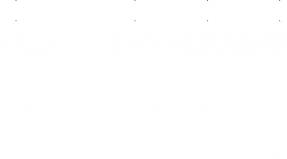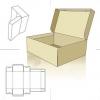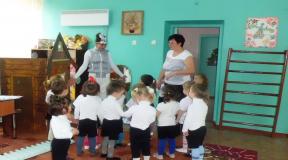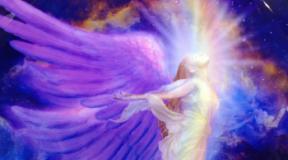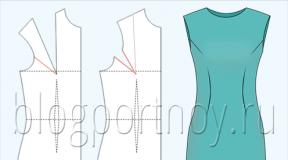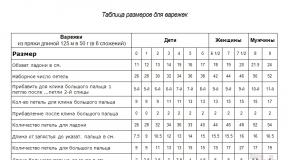Schemes and descriptions of a crocheted tablecloth for the table. Crocheting a tablecloth - instructions, patterns, knitting tips and features of creating patterns. Knitting a round tablecloth
Knitted tablecloths and lace napkins are our grandmothers' favorite home decorations. Looking at the ancient objects carefully stored in chests, we admire the painstaking work and skill of the needlewomen. But is their time really gone?
Knitted tablecloths in modern decor
Some may call this attribute a relic of the last century that does not correspond to modern trends. However, knitting techniques do not stand still; on the Internet you can find a large number of variants of patterns and descriptions of crocheted tablecloths that fit organically into a modern home environment.

In the photo, interiors with knitted tablecloths look elegant, but at the same time cozy and homely. Openwork tablecloths with complex patterns made from fine yarn add a touch of aristocracy to the home, and bright napkins with geometric motifs are used by designers even in high-tech style.









What types of tablecloths are there?
Depending on the type and size of the table, knitted tablecloths are made round, rectangular, oval or any other shape conceived by the designer. Patterns of knitted tablecloths can be solid or consist of individual motifs, which are subsequently sewn together to form a smooth fabric.

When crocheting, the pattern is made by alternating various stitches and air loops in accordance with the pattern. The fabric can be knitted in a circular pattern (with a lifting loop or in a spiral), or in rotating rows.

Using ready-made patterns or improvising, experienced knitters create intricate patterns. The result is incredibly beautiful crocheted tablecloths.

Bruges lace and fillet knitting techniques are also common. Mastering this skill with basic knitting skills is not difficult; it will take a little practice and patience.

Some craftswomen even knit tablecloths with knitting needles. This method is even more labor-intensive and requires serious skills, because it is very difficult to cope with a large number of loops when knitting a wide fabric.

With all the variety of modern materials and the rich color palette of yarn on store shelves, the flight of imagination of knitters is almost unlimited.









Choosing yarn for a tablecloth
When choosing a thread for knitting, you need to know in advance how often the tablecloth will be used. Synthetic yarn is suitable for everyday use - it does not require special care, is easy to wash and holds its shape well in the product. For special occasions, the bias is made in favor of thin cotton, linen fibers or iris.

The calculation of the amount of yarn per product is usually given in the descriptions, but you should take into account the individual knitting density, the thickness of the selected thread and the meter in the skein.

Craftsmen determine the need for yarn experimentally, so to begin with it is better to take materials with a reserve. Practice shows that excess is useful in further experiments, and deficiency is fraught with problems in finding the right color and composition.

If you are just learning how to knit, start with small doilies. Choose clear patterns to practice without confusing patterns. First of all, make sure that the canvas is smooth, without waves or irregularities. The columns must be the same, then the drawing will be readable.

To begin, knit a few test pieces using different sized hooks. This method clearly shows the best combination of three main components: knitting density, yarn used and tool. The sampler will also help you calculate the yarn consumption for the required size of the product.

Choosing a pattern of motifs will help you avoid doubts about the size of the finished tablecloth. This way you can add the desired number of motifs in length or width as you complete the work.

Processing of the finished product
Having finished knitting the tablecloth, do not rush to put it into use - first, the product needs to be given a completed, “marketable” look. This is achieved through the process of wet-temperature treatment.


The edges of the tablecloth are fixed on a flat surface, then steamed and ironed through a damp cloth. During the process, the product is given shape, all the threads are aligned, and the tablecloth takes on a beautiful finished look.

In order for the tablecloth to serve for a long time, it must be washed only by hand, using special gentle products. Handmade work deserves to be treated with care and in return will provide pleasure for many years.

Photo of a crocheted tablecloth






















Good afternoon, friends!
I'm often asked if I have any patterns for crochet round tablecloths, because it's actually hard to find clear patterns on the Internet. I couldn't do it either. Now I have learned to look for the photos I need and I want to offer you six very beautiful tablecloths for a round table with good large patterns, or rather, I will add five more to the one already published on the blog a long time ago.
I myself really like it when a round table is covered with a burgundy or green linen tablecloth, and on top lies a white crocheted openwork one. It is so elegant, elegant, graceful, elegant, beautiful, festive and cozy!
As a rule, thin cotton threads such as Iris, Violet, Narcissus, Lily and others are suitable for knitting, and in some cases it is better to knit from bobbin threads for sewing - zeros. Choose the color to suit your taste and your interior.
According to reviews from needlewomen, the thread consumption for a tablecloth can range from 300 to 800 grams, but this will depend on the pattern, the size of the tablecloth, the threads and the density of knitting.
A hook number 1-1.5 is suitable, and sometimes it’s even better to take a number 0.6.
I have selected only patterns that allow you to knit the entire tablecloth at once, and not from motifs. Crocheting round tablecloths is similar to crocheting a large napkin and many people enjoy it much better.
The finished tablecloth needs to be starched and spread wet on the floor to dry.
Knitting patterns for beautiful round tablecloths
All our diagrams can be downloaded for free. They are very large, so they will need to be opened and viewed in a separate tab, then printed and/or saved to your computer. I checked all the diagrams; when viewed enlarged on a computer, they are perfectly readable, you can even see the number of air loops in the arches.
Openwork tablecloth, model 1

Tablecloth with “Pineapple” pattern, model 2

Once upon a time in the Vesta magazine I found diagrams of this formal tablecloth; they are very simple and just right for beginners. I leave the diagrams in the text of the article.
Cast on a chain of 8 loops, close it in a ring and knit according to pattern I from the 1st to the 26th rows.

Rows 27-31 are worked like the 26th.
Knit the next rows according to pattern II.

Apparently many people have already knitted this tablecloth. My reader Elena generously sent a photo of her beautiful work.
As it turned out, the tablecloth turned out smaller than in the photo from the magazine.

Large round tablecloth, model 3

Tablecloth for a round table, model 4

Beautiful tablecloth, model 5

Small round tablecloth, model 6

Let crocheting a round tablecloth according to one of the selected patterns give you pleasure.
For those who like to knit and use motifs, I suggest you take a look at this one.
Knitted items will help create coziness and a feeling of warmth in the house, and crocheted tablecloths will create a spiritual mood in the kitchen. Many people associate such products with mothers and grandmothers - that is, with their home, warmth and care. Perhaps it's time to create a similar feeling for your loved ones? Crochet patterns and step-by-step descriptions of the work will help with this. And to avoid endless searches for the necessary diagrams and descriptions in magazines and on the Internet, you will need this article.
Crochet tablecloths - patterns with descriptions for beginners
There are many varieties of crocheted tablecloths: round, oval, square, rectangular, runner tablecloths, mini tablecloths, from motifs, solid ones. And there are even more styles of tablecloth knitting. However, they are united by the method of knitting - crochet, so they all have a distinctive feature - openwork, airiness.
Such tablecloths can easily create a festive mood, as well as beautifully decorate meals on ordinary weekdays. One way or another, learning to crochet tablecloths will be a useful skill for any housewife. Therefore, we will consider several interesting models of this product and ways of knitting them.
Knitting a round tablecloth

The round openwork tablecloth has long become a classic. However, today's trends make it possible to replay everything in a modern way, to give new life to the old concepts of beauty. Now simplicity and minimalism dominate the interior, and this directly applies to knitted products. A crocheted round tablecloth can also look modern and fit well into the overall style of decoration. Considering in detail the possibility of crocheting a tablecloth, the pattern for a round table will be very useful.
Tablecloth sizes
Popular articles:
Approx. 76 x 84 cm.
Materials for work
- yarn (100% cotton; 120 m/50 g) – 600 g white;
- hook No. 3.5.
Knitting pattern
 This knitting pattern is divided into two: from the beginning of knitting to number 22, and from number 23 to the end of knitting.
This knitting pattern is divided into two: from the beginning of knitting to number 22, and from number 23 to the end of knitting.  Instructions for crocheting a tablecloth.
Instructions for crocheting a tablecloth. Work progress
Make a chain of 10 vp. and close it with 1 connection. Art. into the ring, then knit the 1st–47th circular rows according to the pattern.
Start each circular row with the number of vp indicated on the diagram. and finish the connection. Art. If necessary, go through with the help of a neighbor. Art. to the beginning of the next circular row or for the 16th
and on the 32nd circular row, reattach the thread.
For better clarity, the diagram shows only part of the tablecloth; complete the circular rows according to the drawing. In total, you will get 8 repeats in the 1st–5th circular rows, 32 repeats in the 6th–21st circular rows, 64 repeats in the 27–37th circular rows, and 96 repeats starting from the 44th circular row.
Assembly
Spread the tablecloth, and each arch of air loops should be secured with a stainless pin.
Cover the tablecloth with a damp cloth and leave until completely dry.
How to knit a tablecloth from motifs

A beautiful thick tablecloth made of floral motifs will help diversify the everyday life of all the inhabitants of the house. Crocheting a tablecloth from motifs is very popular because of the method of execution: first, small elements are crocheted, and then a whole product is sewn from them, although there are also continuous methods of crocheting motifs. Tablecloths made from motifs look very good on tables in bright kitchens, balconies, and living rooms.
Tablecloth sizes
Approx. 76 x 84 cm.
Materials for work
- yarn (100% cotton; 85 m/50 g) - 300 g natural white, 150 g gray, 100 g pink = 1st decorative color and 50 g blue = 2nd decorative color;
- hook number 6.
We knit a hexagon according to the pattern

Using a decorative thread, make a chain of 5 chain stitches. and close into a ring using 1 connection. Art. Continue work according to pattern in circular rows. Start each round row with the initial ch. acc. diagram and complete 1 connection. Art. to the last initial ch. or in the 1st loop of the circular row.
Perform the 1st–5th circular rows 1 time, while performing the initial row and the 1st + 2nd circular rows with a decorative thread, the 3rd circular row with a gray thread, the 4th + 5th circular rows with a white thread thread. When changing color, secure the new thread with 1 connection. Art. acc. scheme.
Knitting density
Hexagon = 12 cm from edge to edge or 13 cm from top to top; These dimensions were obtained by measuring the model.
Pattern

Work progress
Make 25 hexagons with pink and 12 hexagons with blue thread.
Assembly
Arrange the hexagons according to pattern and from the wrong side connect with white thread st. b/n, while inserting the hook only behind the front walls of the edge loops.
How to knit a square pattern

A square crocheted tablecloth is always useful in the house, because it looks equally good on square tables, on round tables, and on rectangular ones, where it looks like a large napkin. Let's look at how to crochet a square tablecloth using the popular fillet technique. In this case we will talk about fillet lace - mesh. Fillet knitting is created from air loops and stitches, and the pattern embroidered on the mesh is replaced by stitches adjacent to each other.
Tablecloth sizes
About 120x100 cm.
Materials for work
- Anchor Liana 10 pink yarn No. 794 from Coats;
- hook No. 1.5
Knitting density
140 cells x 141 rows.
Test sample: 11.5 cells. x 12.5 rub. = 10 x 10 cm lace from st. s/n.
Knitting pattern

Work progress
Start from the middle. Dial 409 v. n., turn. Continue according to the diagram. 1st Art. s/n of each row replace 3 in. p. For adding and subtracting cells, see Starting from the 59th row, complete each sheet of border separately. After finishing the 1st half, turn the tablecloth 180 = and knit the 2nd part on the other side of the initial chain b p. Skip the 1st row, starting from the 2nd. Carefully give the finished tablecloth the correct shape.
On a rectangular table

Rectangular tablecloths are one of the most common models of knitted table covers. They are good for both large holiday tables and everyday use. Let's take a closer look at how to crochet a tablecloth on a rectangular table - a diagram with a description will be useful for those who dream of creating a rectangular tablecloth from square motifs.
Tablecloth sizes
on a table 85x70 cm.
Materials for work
- yarn YarnArt Lily (100% mercerized cotton, 500 g/225 m) - 300 g;
- hook No. 2.
Knitting density
8 motifs wide and 7 high.
Square motif knitting pattern

The border around the edge of the tablecloth is made with a simple arched pattern.
Work progress

Make a chain of 6 vp, conn. Art. close it into a ring, then knit 7 circular rows as follows:
1st row: 14 ch. of which 4 v.p. - lifting loops, *1 st/2n, 10 ch*. From * to * repeat 2 times, 1 connection. Art. in the 1st loop * lifting.
2nd row: 4 ch. of which 3 v.p. - lifting loops, *under an arch of 10 v.p. knit 5 st s/n, 17 ch, 5 st s/n under the same arch, 1 ch, 1 st s/n at the top of st s/2n, 1 ch* From * to * repeat 3 times, replace the last st. s/n with a connection. Art. into the 3rd lifting loop.
3rd row: 4 vp, of which 3 vp. – lifting loops 9 (this is how each next row begins). * at the tops of the st s/n, knit 5 st s/n, 15 ch, 5 st s/n, 1 ch, 1 st s/n, 1 ch*. From * to * repeat 3 times, 1 connection. st into the last loop of the climb.
4th row: 4 vp, * 5 st s/n, 13 vp, 5 st s/n, 1 vp, 1 st s/n, 1 vp* From * to * repeat 3 times.
5th row: 4 ch, * 5 st s/n, 6 ch, under the arches of the previous three rows, knit 2 st b/n, 6 ch, 5 st s/n, 1 in .p, 1 st s/n, 1 vp* From * to * repeat 3 times. Finish each row with st.
6th row: ch 4, * 5 dc, ch 8, 1 dc on top of the previous row, ch 4, dc, 8 vp, 5 st s/n, 1 vp, 1 st s/n, 1 vp* From * to * repeat 3 times.
7th row: 4 vp, * 5 st s/n, 9 vp, under the arch of 4 vp. knit 3 st b/n, 11 vp, 3 st b/n, 9 vp, 5 st b/n, 1 vp, 1 st s/n, 1 vp* From * to * repeat 3 times.
For connecting motifs when knitting corner arches from 11 ch. make 6 vp, then connect the hook. Art. with an arch of the second motive, 6 v.p.

The sides of the motif are connected at the vertices of the st s/n. To do this, *before knitting a st s/n, remove the hook from the working loop, insert the hook behind the half-loops of the column of another motif, grab the working loop with the hook and pull it through the top of the column of the motif being joined.
Knit the main part of the tablecloth by connecting the motifs as you knit.
Beautiful openwork tablecloth

Probably every housewife has a beautiful openwork tablecloth for a special occasion. And if not, then you should definitely buy one, or better yet, make it yourself. Let's take a closer look at how to crochet a beautiful openwork tablecloth.
Tablecloth sizes
About 130 cm.
Materials for work
- Ecosse yarn No. 10 natural color - 450 g;
- hook No. 1.25.
Knitting pattern
 Tablecloth motif from rows 1 to 17.
Tablecloth motif from rows 1 to 17.  Tablecloth motif from rows 17 to 53.
Tablecloth motif from rows 17 to 53.  Tablecloth motif from rows 53 to 85.
Tablecloth motif from rows 53 to 85. Knitting density
from 1st to 3rd row = 5 cm.
Work progress
Knitted in the round.
1 st.: start with the ring formed by the end of the thread, repeat 3 times * 1 tbsp. with double crochet, 1 air. p., 1 picot, knitted trace. way:
3 air p., 1 tbsp. b/n, knitted in the first air. p., 2 tbsp. with double crochet, 1 air. p., 1 picot. 1 tbsp. 6/n, 1 air. p., 1 picot, 1 tbsp. with a double crochet* close the row of connections. st., knitted in the 3rd of three air. p., replacing the first art. double crochet
2 p.: repeat 3 times * 1 tbsp. with double crochet, 5 air. p., 2 tbsp. with double crochet, 5 air. p., 1 tbsp. double crochet, knitted in picot, 1 tbsp. with a double crochet, knitted in the next picot, 5 air. p., 1 tbsp. with a double crochet *, close the row of connections. st., knitted in the 3rd of three air. p., replacing the first art. double crochet
3 p.: 1 air. p., 1 tbsp. b/n, then repeat 8 times *5 tbsp. b/n in each arch, 2 tbsp. b/n *, 5 tbsp. b/n in each next arch, close row 1 tbsp. b/n and 1 connection st., knitted in air. p. at the beginning of the row.
4-85 rubles: continue working, following the instructions of the diagram and accompanying
symbols. Begin the 4th, 8th, 11th, 27th, 34th, 45th, 84th and 85th rows with an additional forward moving connection. Art. before starting to knit a row. Close each row of connections. st.. knitted in air. l. beginning (or the 3rd of three chain stitches, replacing 1 double crochet stitch). Cut the thread at the end of the 85th row.
Video lesson
It is always easier for any needlewoman to start a new project by watching knitting master classes. Crochet tablecloths are no exception, because there are many ways to knit them, and it is simply impossible to know them all.
Video “crocheting a tablecloth”
In fact, a tablecloth is a multifunctional item that plays a big role in the interior design of a room. Tablecloths are classified according to the following parameters:
- By purpose (protection of the table surface, for convenience, so that dishes do not slide on the tabletop, decorative functions, etc.);
- According to the form;
- According to the material of manufacture (oilcloth, fabric or knitted tablecloth).
Knitting a tablecloth
Knitting a tablecloth is not an easy task; it requires a lot of time, effort, patience and inspiration. However, the final result, knitted tablecloths, looks elegant and original.
Not every housewife can surprise guests with a table that is decorated with a real work of art - a tablecloth knitted with her own hands.
Many needlewomen believe that a beautiful openwork tablecloth can only be crocheted. This is not so, you need to choose the right threads and knitting needles, carefully study the tablecloth pattern and you can start creating masterpieces.
Rectangular tablecloth
Beginning craftswomen are not recommended to immediately take on large-scale products. It’s better to practice knitting simple rectangular napkins. With this you will fill your hand and decorate the interior of your home. Several crocheted napkins will give you confidence in your abilities; a tablecloth is essentially the same napkin, only larger. It is easier to knit a rectangular tablecloth because it is easier to correct a mistake than in a tablecloth knitted in the round.
Oval and round tablecloths
Openwork round tablecloths will become a real decoration for a small table in the kitchen or coffee table. Patterns and ornaments with plant motifs - flowers, leaves - are well suited for such things.
At first it may seem that it is difficult to knit “leaves” - weaves, decreases, yarn overs. But if you strictly adhere to the description of knitting a tablecloth, then the “leaves” will not seem complicated to you.
We offer patterns of tablecloths knitted with openwork patterns.
Knitted tablecloth, models from the Internet
Square tablecloth knitted
Knitting patterns





Beautiful tablecloth knitted in peach color

Round openwork tablecloth knitted

Knitting pattern
Square tablecloth knitted

- Designer – Herbert Niebling
- Published: Beyer Bunte Reihe Band 7014, Beyer Kunststricken: Heft 4
- Burda 305, Alles aus Garn: Kunststricken Folge 2
- Anna, 04/1984
- Dimensions: 52 x 52 cm
Material and tools:
- 40 g yarn MEZ-Glanz No. 60
- Two sets of double needles No. 1.25 – length 21 cm
- Hook No. 0.6 mm or 0.75 mm
Tablecloth knitting description:
Cast on 8 loops and join into a circle.
Distribute the stitches onto 4 knitting needles and knit 4 rows.
Next, knit in accordance with pattern A - repeat rapport 4 times. From three yarn overs lying next to each other, knit 10 loops each (knit alternate knit and purl loops).
After row 117, knit 4 rows. In the first front row, 8 times after every 65 stitches from the broach between the loops of the previous row, knit one front crossed loop. After these increases there are 532 stitches on the needles.
Make the teeth of the tablecloth according to pattern B. On each side, repeat the rapport 7 times, then for the corner, make a pattern to the left of the bold line (there are 6 leaf motifs in the corners - see photo).
After the 34th row (front row), close the loops with a crochet hook, knitting 12 chain loops between single crochets.
Yes, 4 knit rows without increases (this is at the very beginning of knitting, after 8 stitches were distributed on 4 knitting needles), that’s right, I was also surprised, but I knitted it, maybe not 4, but 3, I don’t know for sure , it’s hard to count them there. Girls, it turns out that it’s fun to knit a square on 4 knitting needles!
Just a hint (there is no such mark in the description of this particular model, but in the general recommendations for knitting napkins, tablecloths, shawls on 4 knitting needles): since we knit in a spiral, it is not difficult to get lost and lose the beginning and end of the circular row, so in one of the corners let the marker hang all the time, move it as the fabric increases, closer to the knitting needles. He will tell you that you are already on the fourth needle and it’s time to move on to the next row of the pattern.
And one more thing: the diagram shows a repeat for one knitting needle; it is knitted the same way on all four knitting needles. Empty cells in the diagram do not mean anything at all, and the numbers in an empty cell (or in the middle of several empty cells) mean the number of knit stitches that need to be knitted between other characters (for example, between two yarn overs).

Yellow tablecloth knitted


Tablecloth knitting patterns
Square tablecloth by German designer Herbert Niebling
Size 90-90 cm. The tablecloth is knitted from 200 g cotton yarn (210m/50g) with knitting needles No. 2.5.


Tablecloth knitting pattern
Since most of the patterns are without translation and symbols, we present several options for designating loops when knitting:
Knitted tablecloth, models from our website
The tablecloth is knitted from 100% thin acrylic yarn in 2 folds. We start knitting with 8 air loops closed in a circle, then knit according to the pattern until the last row, finish crocheting, wash, dry on the template, the tablecloth is ready. Enjoy watching and easy loops for everyone!
Tablecloth based on Heinrich Nibling's design. This is the well-known Lyra tablecloth. True, I changed the border a little. SOSO threads, made in Japan.
Skeins of 50 g. Skein length 240 meters. It took almost 20 skeins. Knitted with needles No. 3. There are two options available in white and beige yarn.
Second tablecloth made according to the pattern of the knitting album with BURDA knitting needles - 418, model 23. It took about 15 skeins. The work is very elegant and will decorate any interior.
The third tablecloth is knitted – Clematis
A very simple model. Any craftswoman can knit it without any problems. Yarn - Successful pekhorka. It took about 15 skeins of 50 g. It’s even better to use SOSO. It takes about the same. But this yarn is silkier and of higher quality, and starches better.



